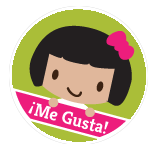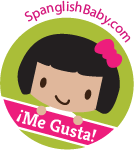
My daughter is at that stage when she actually thinks helping is fun—well, at least most of the times. When we come back from the doing groceries, I usually ask her to help me carry some of the less heavy bags from the garage to the kitchen. Once we’re there, she helps me put away some of the stuff in both the fridge and the pantry. Not only does this make her feel useful—and big—which is great for her self-esteem, but it’s also a great opportunity to learn more vocabulary as she usually has questions about the things she’s putting away or sometimes they remind her of something that happened at, say, preschool.
Sometimes, though, she wants to help and she’s really still too little for some things: carrying her baby brother comes to mind. I think this is one of the reasons she was able to immediately identify with Perico, the main character in award-winning children’s author Alma Flor Ada‘s latest book, Let Me Help!/¡Quiero ayudar! Published by Children’s Book Press, one of our favorite multicultural publishing houses, the bilingual book tells the story of a parrot which belongs to a family who’s in the middle of all the preparations for their Cinco de Mayo celebration. Perico goes around saying, ‘quiero ayudar‘ to each member of the family involved in a different activity, but he is turned away by each one of them.
“I have been always aware of the great joy there is for children when they are allowed to be part of what adults do and the disappointment when they are not allowed to help,” said the author about the internal source of inspiration for the book. “Then, comes the external stimulus. I love the city of San Antonio. In the many occasions I have been fortunate to visit, either to speak at conferences or to give workshops or presentations, I have enjoyed many a nice walk along the river banks. At a given moment, the colorful barges made me think of parrots… and before I knew it, there was the idea for Let Me Help.”
 Flor, a pioneer in the field of bilingual education and the author of hundreds of children’s books, writes in both English and Spanish and then translates them or has one of her daughters, who began translating her writing since she was very young, do it for her. Born and raised in Cuba, Flor didn’t learn English until she was a teenager when she chose to spend a summer in the U.S. instead of having a Quinceañera party!
Flor, a pioneer in the field of bilingual education and the author of hundreds of children’s books, writes in both English and Spanish and then translates them or has one of her daughters, who began translating her writing since she was very young, do it for her. Born and raised in Cuba, Flor didn’t learn English until she was a teenager when she chose to spend a summer in the U.S. instead of having a Quinceañera party!
“I consider bilingualism a great asset and feel that all children should be given the benefit of growing with two or more languages,” she said. “For Latino children, whose parents primary language is Spanish, it is essential to maintain and develop the use of Spanish in order that the parent’s role as educator is not eroded.”
According to Flor—who began writing out of her discontent with the books available for her own children—one of her biggest hopes in writing children’s books is that parents use them as opportunities to have fun with their children, to discover ideas and to teach them about important topics.
“I would hope that Latino parents who are fluent in Spanish would choose to read the book in Spanish with their children and to talk about it in Spanish,” she expressed. “But by being in two languages the book offers all opportunities in all cases: a parent can read the book in one language and encourage the child to read it in another, they can compare and contrast the two texts, and find cognates, words that are very similar in form and meaning in both languages and also discover the differences. The possibilities are endless… in all cases they should be fun and rewarding.”
Here’s the rest of the interview:
As a writer, can you talk about the importance of literacy among the Latino community?
“Literacy is essential for all communities. A child who learns to read well and who reads for pleasure will have higher academic achievement.
Most Latino parents who have immigrated to this country have done so looking for better economic opportunities for themselves and better educational opportunities for their children.
It is important that parents recognize that they are the first and best teacher for their children.”
What do you think about the concept of raising kids bilingual and bicultural?
“Bilingualism is beneficial to brain and soul. It makes us better able to understand new concepts, new realities and people who may have different worldviews than us. It is a personal richness and a good step towards achieving lasting peace. For me, it is primarily a tool to increase my possibilities of being useful to others.
While bilingualism is available to all, biculturalism requires the opportunity to experience a culture different from the societal dominant culture. If at least one of the parents or caretakers is a member of a culture different from the mainstream culture the child will be richer by being exposed to both.”
Why write for children?
“There is something very special about writing for children. They are very honest and sincere in their comments, their likes and dislikes. And, since books meant so much for me when I was a child one of my dreams is that children will also consider my books their good friends.”
How has it been working with Children’s Book Press?
“I got acquainted with Children’ Book Press when they first began publishing books in the late seventies. I was very excited about the prospect of bilingual books that would come directly from the community. It was a pleasure to collaborate correcting the Spanish of some of the early books and translating many of them. I have always been a friend and promoter of Children’s Book Press, including their books in my workshops, courses and writing about children’s literature. It has felt wonderful to become, after so many years, an author of CBP and to find myself in the same list with many dear friends.”
The Giveaway
This giveaway is now closed! Congratulations to our winner – #5 Susan!!!
As part of this month’s ReadMe, one lucky reader will get a copy of Let Me Help!/¡Quiero ayudar! Just share with us how your children like to help around the house, or how you would like them to help.
This giveaway ends at midnight EST on Friday, May 7, 2010. Entries/Comments that do not follow the submission guidelines will be invalid and automatically deleted. Sorry, just need to keep it fair. Good luck to all!





I would love to win this book, my son loves to help me most of the time. He loves to read books but most of them are English not in spanish the only one he likes in spanish is Huevos verdes con jamon by Dr Seuss. I want my son to love to read in spanish and to communicate in spanish. Not sure what we are doing for 5 de Mayo maybe i’ll take him to the park.
Thank you!!
We are doing a potluck at the park with Mexican food. It will be a yummy celebration!
.-= Tati´s last blog ..El Dia de Los Libros: Diez Deditos Giveaway =-.
My 5 year old son, Ethan, and I are going to head down to MOLAA to check out their new art program – a bit of a trek for us, but it sounds like a lot of fun.
I’ve provided details below for anyone who might be interested.
Thank you for the chance to win such a great book!
Heather
Museum of Latin American Art: Abejitas Art Club:
For children 3-6 years. 11:00 -11:45 a.m.
The museum’s newest program for young children, Abejitas Art Club, encourages children from three to six years old to explore art, movement, and the five senses in a bilingual environment.
Projects include creating edible paint, crafty clay, and more.
Museum of Latin American Art
628 Alamitos Avenue
Long Beach, CA
Looks like a great book! My oldest son’s favorite way to help around the house is laundry. Oddly enough, he likes to wash it, dry it, and hang it up.
.-= Adriana´s last blog ..Rosas de Abuela =-.
My little girl likes to help me cook and occasionally fold clothes. My middle boy is great at making his bed and putting stuff away…and the baby is great at messing everything up! Thanks for the chance to win this book!
My 4-year-old daughter likes to help with most everything I do like preparing meals – she can measure and stir ingredients, get things out and put them up, washing dishes – I wash, she rinses, laundry – she’s really good at sorting. I wish she would like to help herself do things like pick up her toys from the family room and clean her bedroom.
.-= Sherri´s last blog ..Spanglish Baby =-.
My boys have always been very helpful around the house. People told me they would grow out of it, but so far I’ve had good luck. The oldest likes to help his father mow the lawn and the youngest likes to help me fold the laundry, (though admittedly, he spends just as much time burrowing under the laundry as folding it!)
BTW – We just got this book from the library last week and my youngest son and I enjoyed reading it. I read the Spanish to him and he read the English to me.
.-= Sra. López´s last blog ..Habla =-.
My boys are (almost) always happy to help clean up around the house, and the older two are so good at lending a hand with their hermanito.
My daughter loves to help with everything from unloading the dishwasher to folding laundry. The only thing she is actually really helpful in doing is helping me wash,dry and rip up lettuce for a dinner salad.
The kids do have their chores, but they love to help mom and dad whenever they can.
bgcchs(at)yahoo(dot)com
Bear helps in so many ways. She helps by setting the table, taking her dishes to the sink, helping with her baby brother, and putting her clothes in the hamper. She’s still little, so sometimes she won’t take her dishes to the sink b/c she doesn’t want to, but for the most part she does an awesome job!
.-= Julie´s last blog ..We Play – Blocks and Trains =-.
My 6 year old helps make his bed, folds his own clothes, and sometimes he helps me with cooking (especially if it involves kneading). My 3 year old still doesn’t help much so I guess I got some work to do there. I definetely think giving them responsibilities is good for them, though.
Thank you for your review of this book and interview of Ama Flor Ada. I loved her kids poetry book, Mambru.